
Posted on 10/19/2014 4:56:29 AM PDT by Homer_J_Simpson

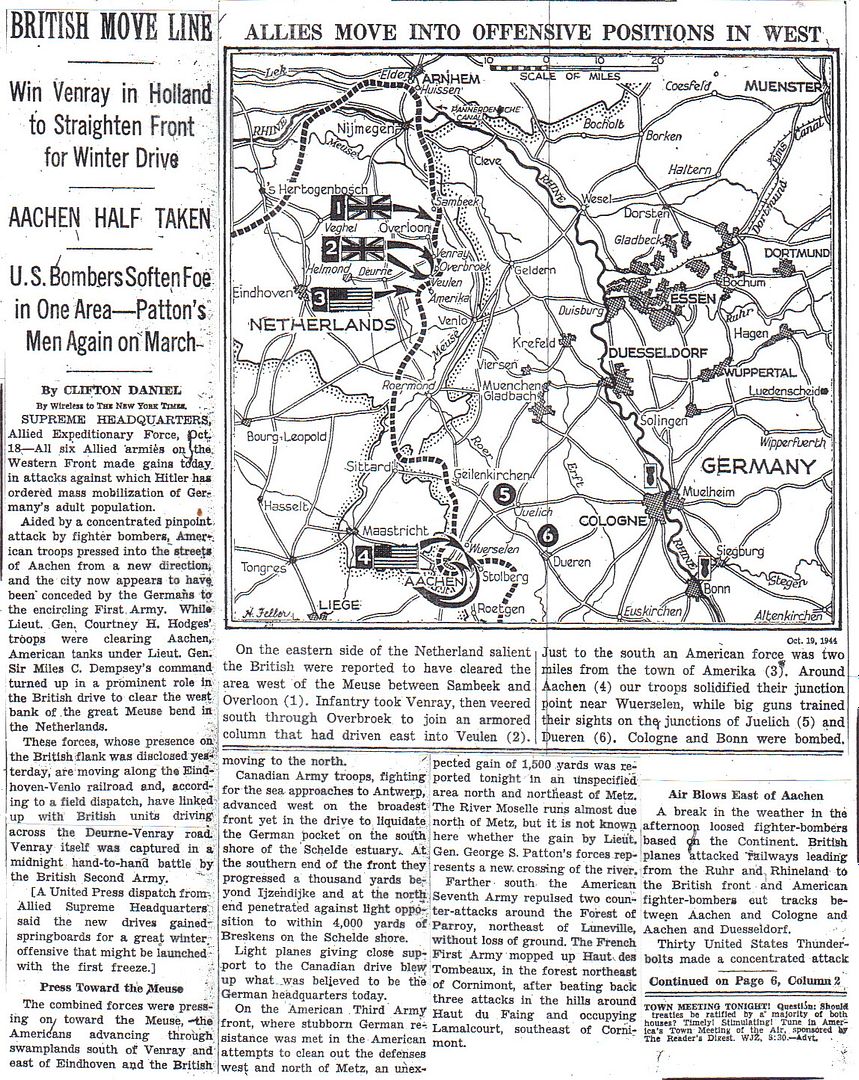
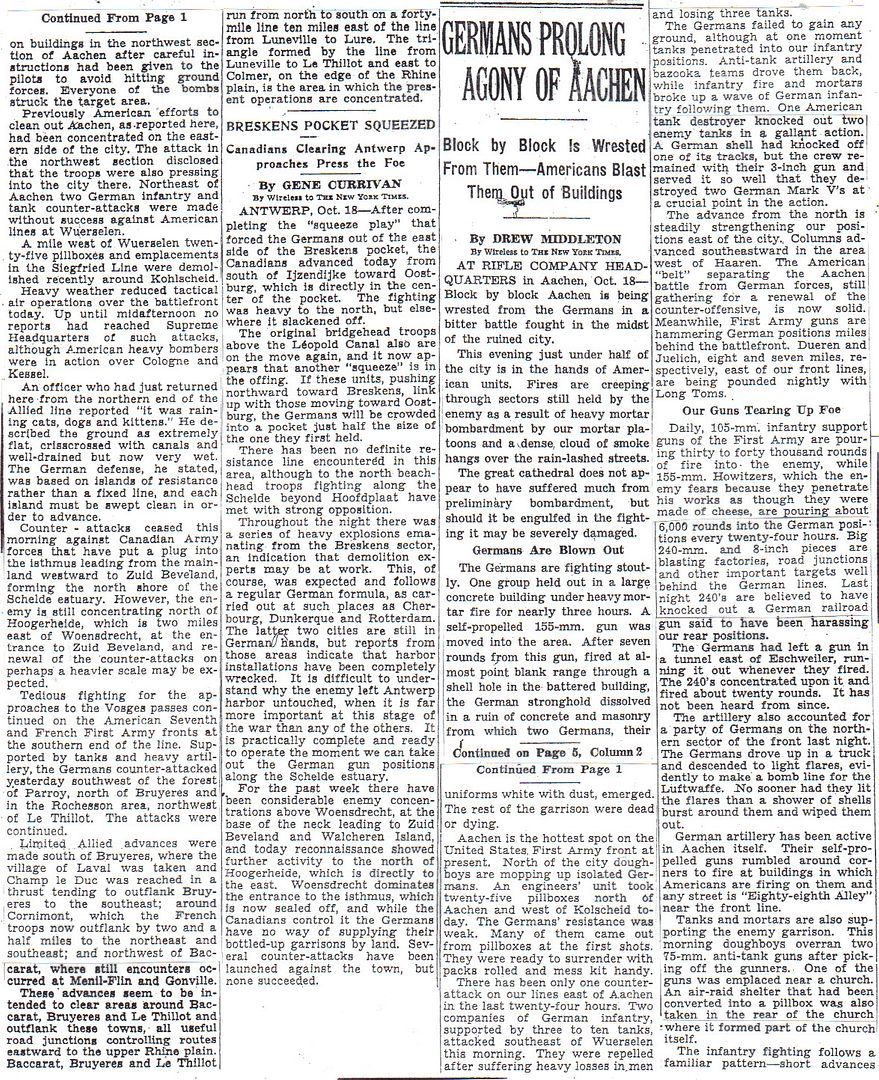
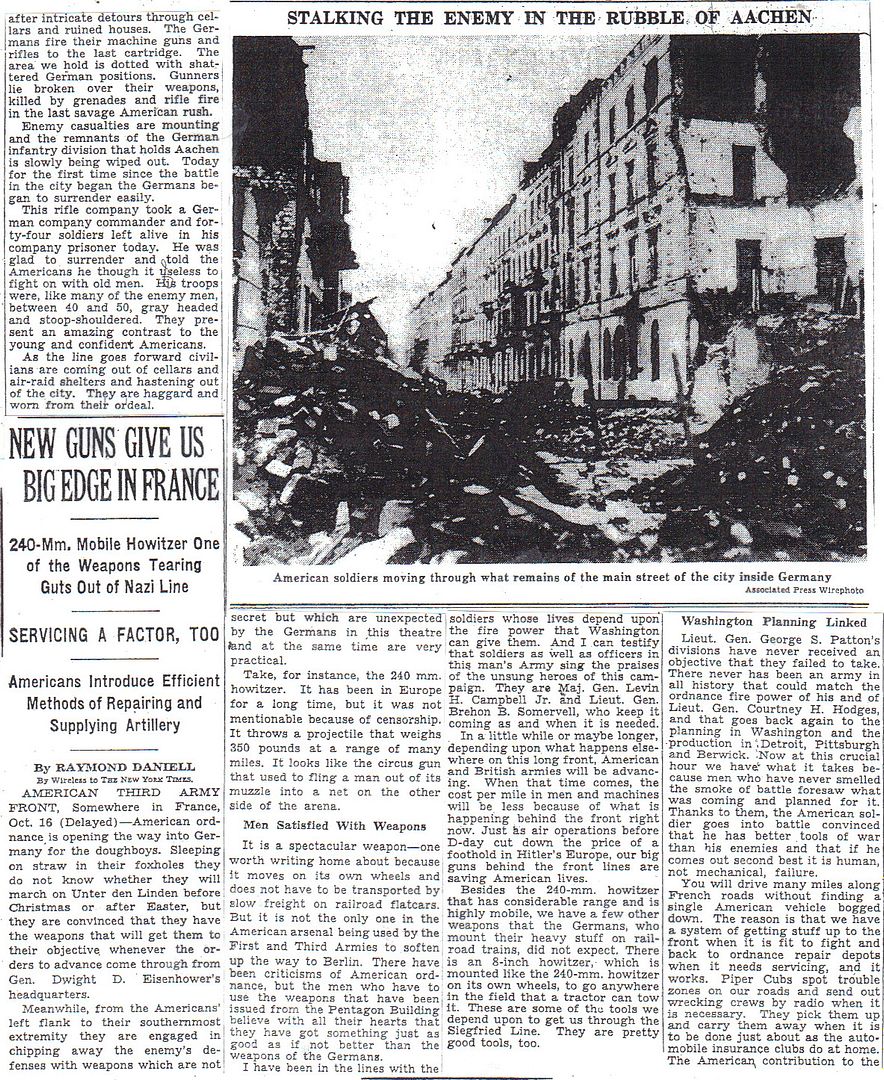
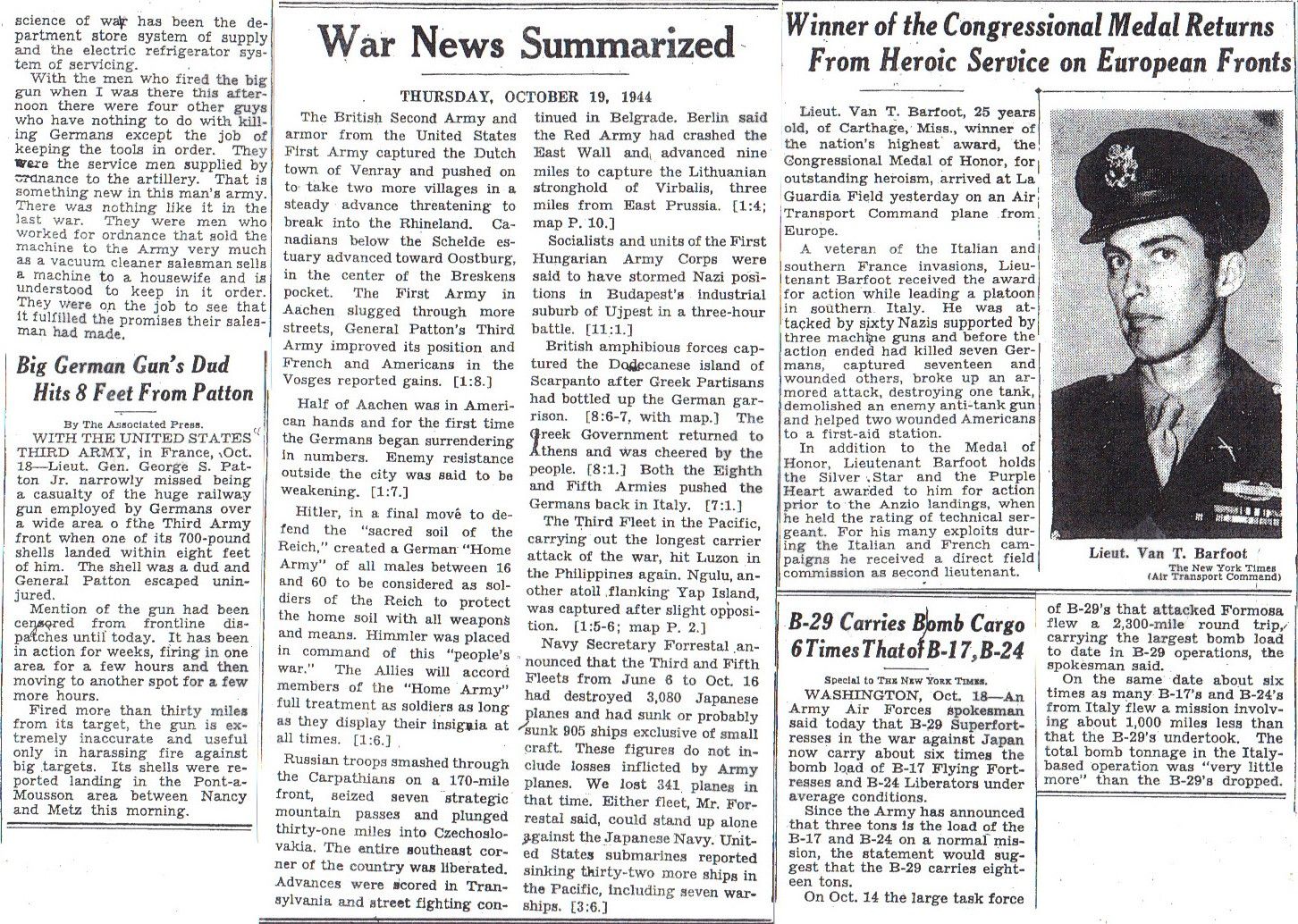

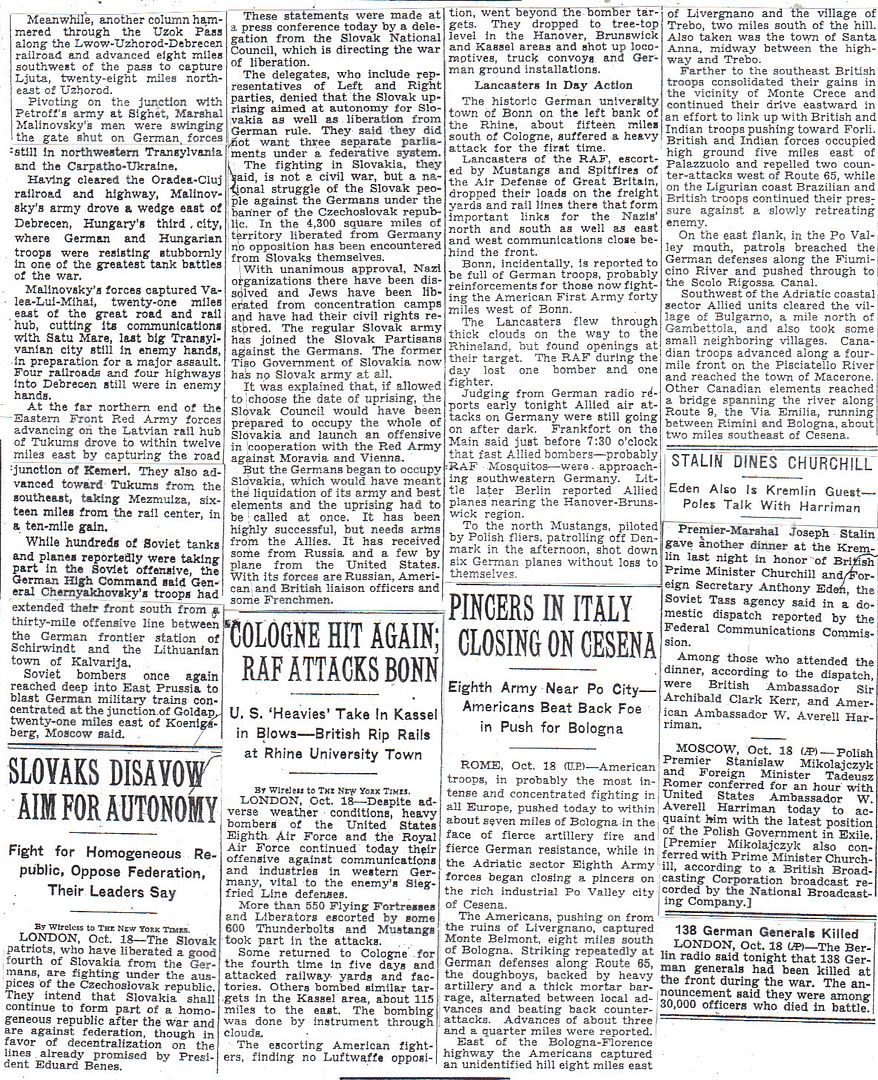
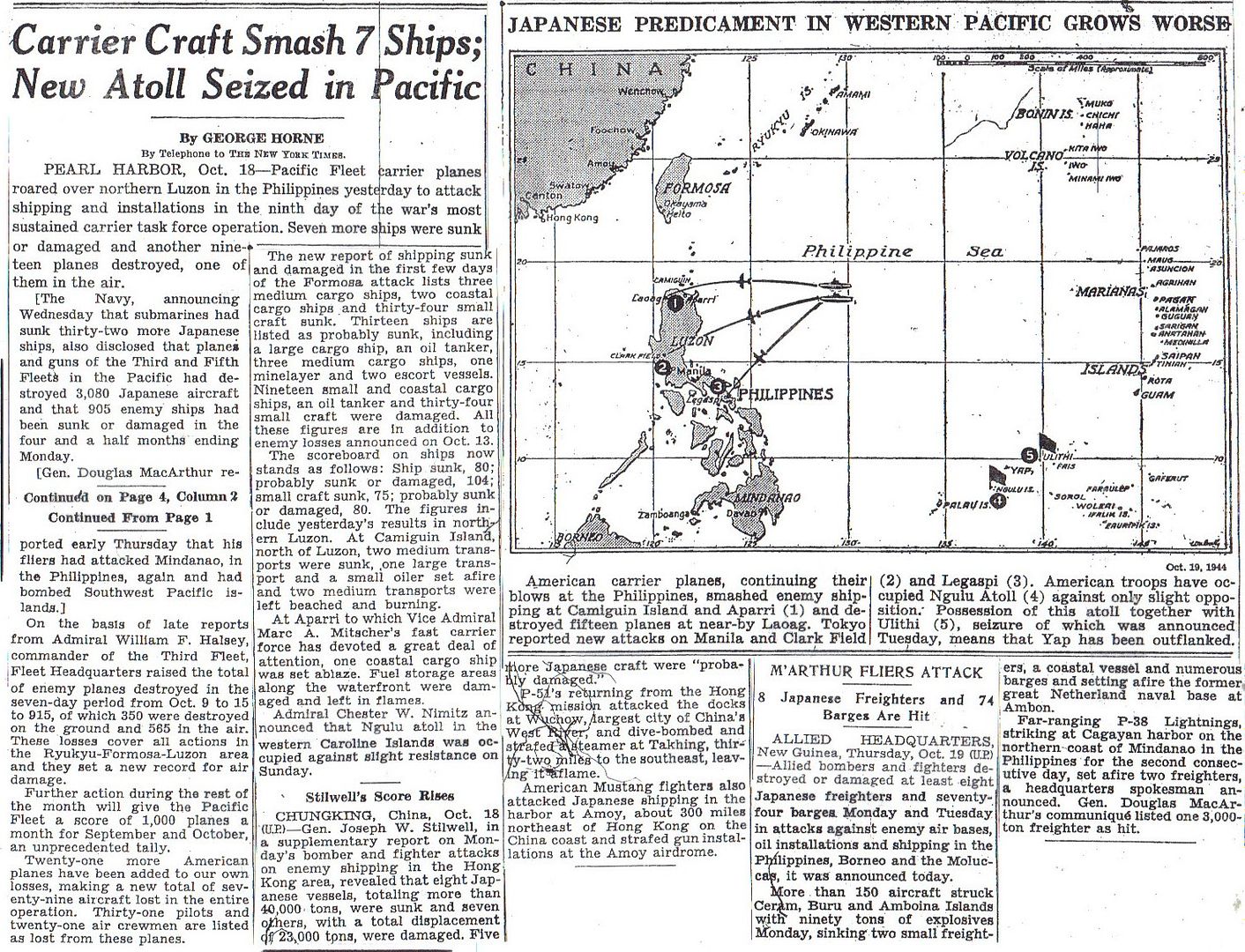
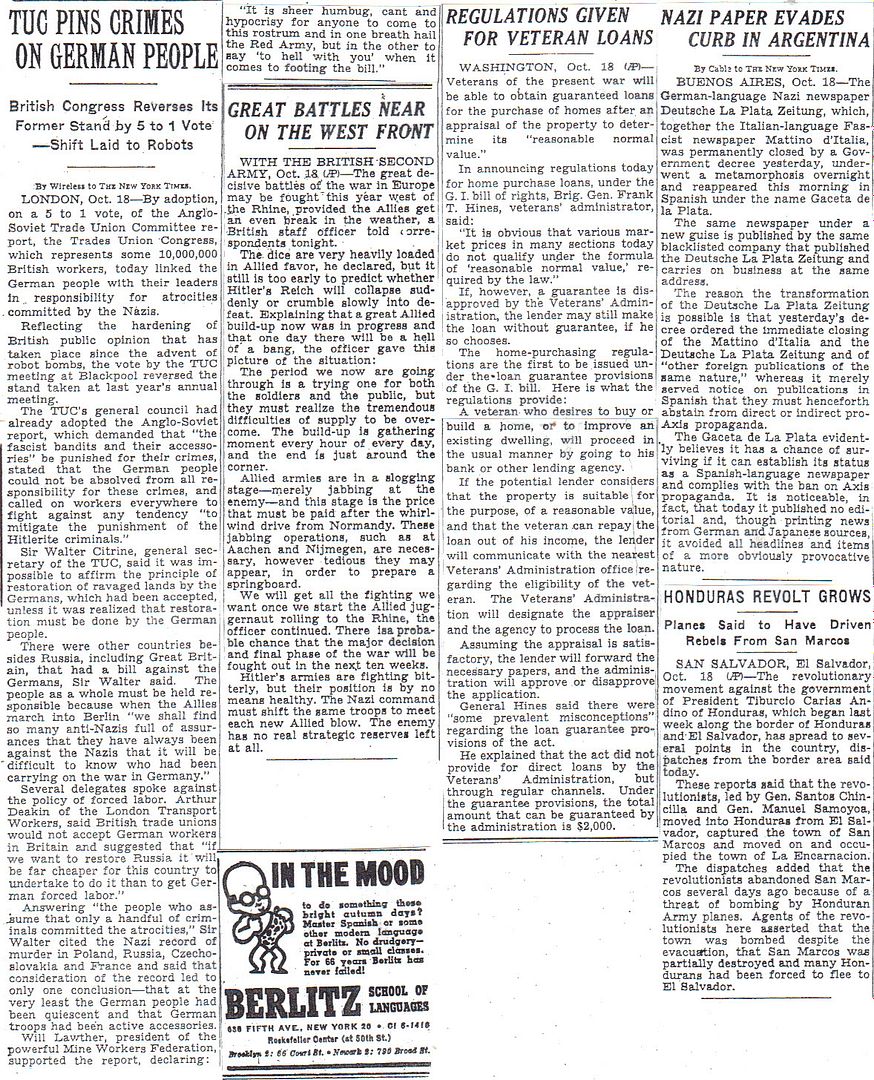
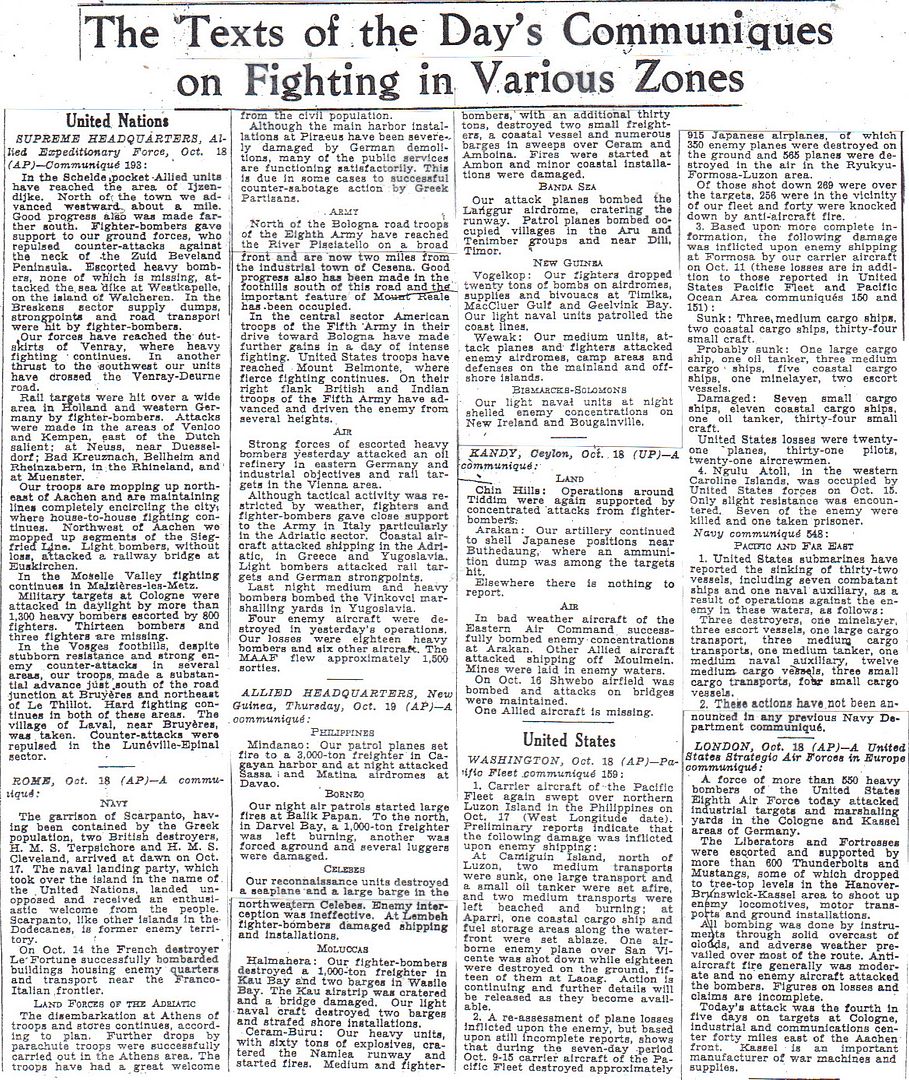
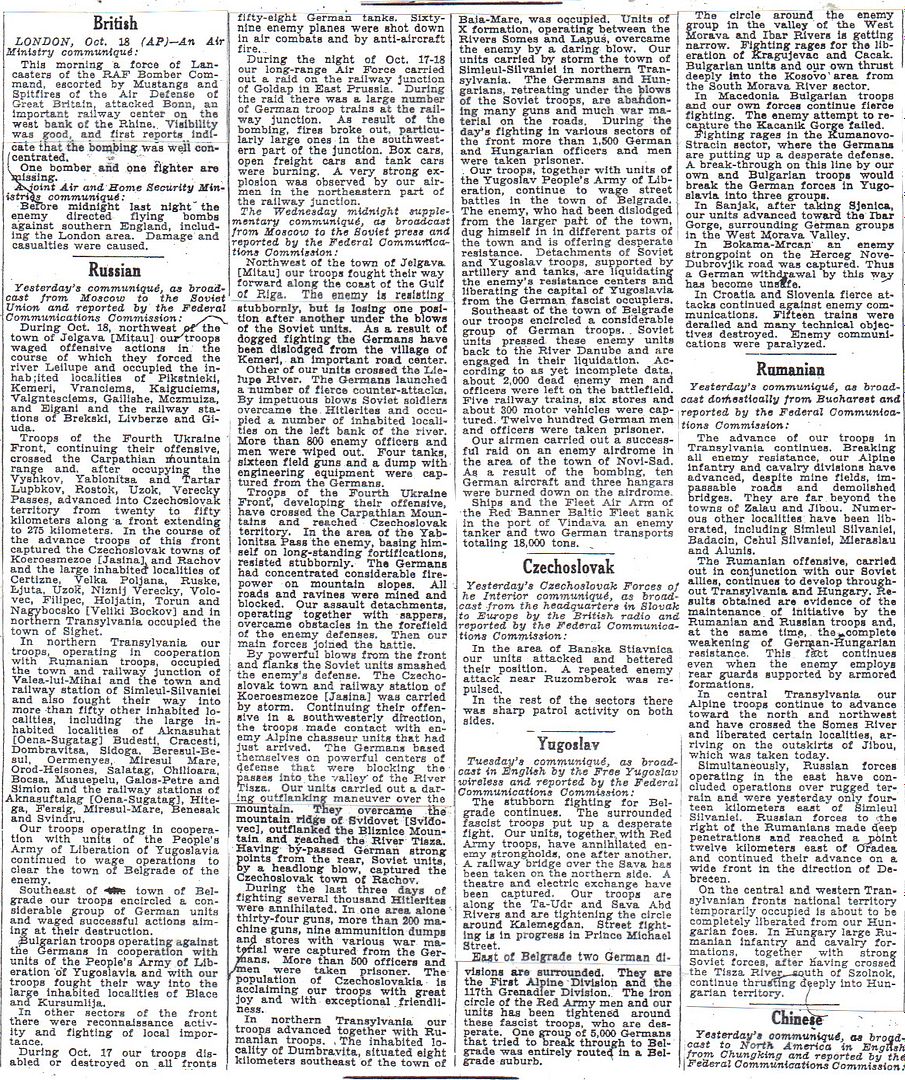
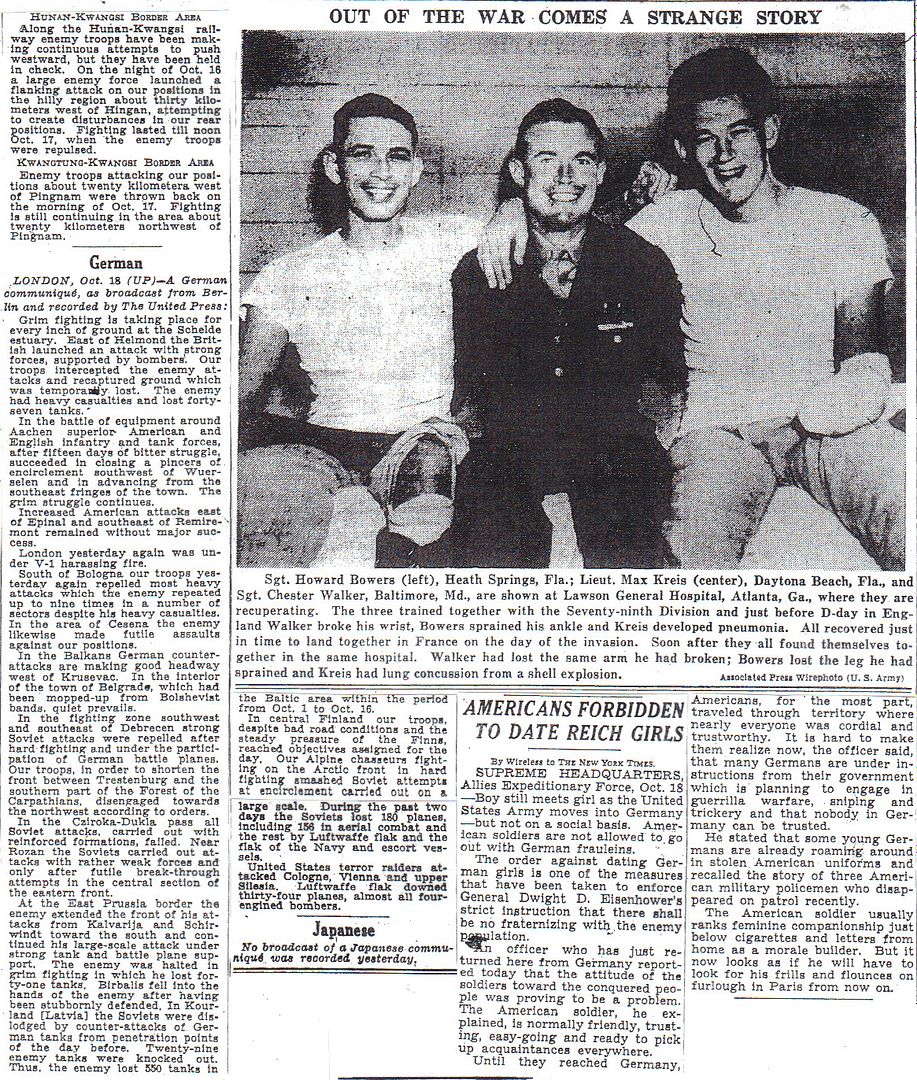
http://www.onwar.com/chrono/1944/oct44/19oct44.htm#
British capture Tiddim
Thursday, October 19, 1944 www.onwar.com
In Burma... British forces capture Tiddim.
In the Philippines... The American escort carriers of TG77.4 continue air strikes on Leyte. The US 15th Air Forces raids targets on Mindanao. The Japanese air forces suffer substantial losses in the ongoing American operations. Remaining aircraft are concentrated on Luzon in 1st Air Fleet (Admiral Onishi).
In the Nicobar Islands... Elements of the British Eastern Fleet continue diversionary operations with air strikes on the islands. Considerable damage is caused but the operation fails to divert Japanese attention from American operations in the Philippines.
On the Western Front... American attacks on Aachen continue. Farther south, forces of the US 7th Army capture Bruyeres. Nearby, other units prepare to assault St. Die.
In Italy... Troops of the British 10th Indian Division, part of British 5th Corps (an element of British 8th Army) attack across the Savio River.
http://www.etherit.co.uk/month/9/19.htm
October 19th, 1944 (THURSDAY)
UNITED KINGDOM: The Eighth Air Force flies 2 missions.
Mission 683: 1,022 bombers and 753 fighters in 3 forces attack targets in Germany using PFF or GH; 5 B-24s, a B-17, a P-47 and a P-51 are lost:
- 381 B-24s are dispatched to hit the diesel engine and armored vehicle plant at Gustavsburg (50) and the Mainz marshalling yard (280) the secondary target; 5 B-24s are lost. Escort is provided by 195 P-47s and P-51s; a P-47 is lost.
- 217 B-17s hit the secondary target, Mannheim; 34 others hit a target of opportunity; a B-17 is lost. Escort is provided by 286 P-47s and P-51s; a P-51 is lost.
- 374 B-17s are dispatched to hit an artillery tractor plant at Mannheim (25); 257 hit the secondary, Mannheim; targets of opportunity are Karlsruhe (32), Kreuznach (10), Rudesheim (9), Bad Kreuznach (8), Steyer (2) and other (21). Escort is provided by 226 P-47s and P-51s.
Mission 684: 5 B-17s and 5 B-24s are dispatched to drop leaflets in France, the Netherlands and Germany during the night.
Frigates HMS Loch Tarbert and Widemouth Bay launched.
BELGIUM: In the Canadian First Army’s II Corps area, the newly arrived 52d Division enters action, taking over the Canadian 3d Division’s bridgehead north of the Leopold Canal and continuing the reduction of the Breskens Pocket. A junction is made between the Leopold Canal and Savojaards Plaat bridgehead forces.
FRANCE: In the U.S. Seventh Army’s VI Corps area, the 36th Infantry Division completes the capture of Bruyères after three days of fighting. he 100th Infantry Battalion, 36th Division, takes Hill A, the key to Bruyeres, the 2nd Battalion takes Hill B, and enters the town. The 3d Infantry Division, less the 30th Infantry Regiment which remains in the Le Tholy area, closes in an assembly area behind the 45th Infantry Division in preparation for a drive on St Die. (Gene Hanson & Jack McKillop)
Barney Hajiro, a member of the US 442nd Regimental Combat Team, was a sentry on top of an embankment when he assisted Allied troops attacking a house 200 yards away by exposing himself to German fire directing fire at a strongpoint. He either killed or wounded two German snipers. (MOH)
GERMANY: German resistance is being worn down by the continuing fighting around Aachen.
The German commander exhorts his men to fight to the last man.
In the U.S. First Army’s VII Corps area, German resistance at Aachen is diminishing rapidly; efforts to break the encirclement from outside the city cease and the garrison is told to fight to the finish. The 26th Infantry Regiment, 1st Infantry Division, continues to clear the city and takes Salvator Hill. Task Force Hogan, 3d Armored Division, seizes the Lousberg heights and is given task of cutting the Aachen-Laurensberg highway.
“U.S. Major General Pete Corlett [commander XIX Corps] had been under intense strain since D-day. As I said previously, his health was not good. During the Aachen fight, he showed signs of breakdown. Unable to control a red-hot temper, he antagonized Hodges [commander, United States First Army] and his staff and, as he recalled candidly in his memoir, even his own loyal staff. On October 19, I relieved him of command, without prejudice, and recommended that he be returned to the States for ‘rest and a complete physical check-up.’ I replaced him with Ray McLain, the National Guardsman who had so ably commanded the 90th Division.” [From A General’s Life by Omar Bradley] (Jay Stone)
The Red Army pushes into East Prussia.
In East Prussia, the Soviet Army forces the withdrawal of the German 4.Armee (Hossbach) from the Tilsit area.
Alfred Naujocks deserts to the Americans and at Nuremberg the following year gives a number of sworn affidavits. In one he gives his account of the “faked incident” at Gleiwitz on the evening of 31 August 1939, which Hitler has used to justify his attack on Poland. (Shirer I)
During the night of 19/20 October, RAF Bomber Command dispatches 565 Lancasters and 18 Mosquitos in two forces, 4.5 hours apart to bomb Stuttgart; 564 aircraft hit the city with the loss of six Lancasters. The bombing is not concentrated but serious damage is caused to the central and eastern districts of Stuttgart and in some of the suburban towns. Among individual buildings hit are the important Bosch factory. A second mission is flown to Nuremburg by 263 Lancasters and seven Mosquitos; 258 aircraft bomb the city with the loss of two Lancasters. This is only a partial success for the No 5 Group method and the knock-out blow on Nuremberg, which has eluded Bomber Command for so long, is not achieved. The target area is found to be almost completely cloud-covered. The aiming point is believed to have been the centre of the city but the local report says that the bombing fell almost entirely in the southern districts, but this is the industrial area of Nuremberg. Mosquitos fly two mission without loss; 44 of 48 aircraft sent bomb Wiesbaden and five of six dispatched bombs Düsseldorf.
In Western Europe, weather prevents Ninth Air Force bomber operations but fighters attack a tank concentration east of Luneville, France, strafe targets northwest of Kaiserslautern, Germany, fly reconnaissance in western Germany, and provide cover for US Third and Seventh Army forces in eastern France.
U-2535, U-3026, U-4701 laid down.
U-3013 launched.
U-2515, U-3008, U-3507 commissioned.
NORWAY: U-957 (Type VIIC) is in collision with a German steamer in Lofoten Islands (Norway) and taken out of service at Trondheim on 21 Oct 1944. It is taken to England on 29 May 1945 and broken up. (Alex Gordon)
ITALY: In the U.S. Fifth Army area, elements of the 6th South African Armoured Division gain positions on the slopes of Mt. Salvaro, though elements to the right are still short of Mt. Alcino, southeast of Mt. Salvaro. In the II Corps area, since the 34th Infantry Division has been unable to break through in center of corps front, the main effort is shifted to the right flank toward Mt Grande and Mt. Cerere. After reaching favorable positions for an attack and saturation bombardment of Mt. Grande area by aircraft and artillery, the 88th Infantry Division attacks in the evening, taking Mt. Cerere with ease and reaching the crest of Mt. Grande by dawn of 20 October, 24 hours ahead of schedule. The 85th Infantry Division assists the 88th and gains lower slopes of Mt. Fano. In the British XIII Corps area, the 78th Division attacks toward Mt. Spadura and Mt. dell Acqua Saluta with the 38th and 36th Brigades, respectively, taking the latter and gaining a precarious hold on Mt. Spadura. The 21st Brigade, Indian 8th Division, clears Mt. Pianoreno. The 17th Brigade gets elements to the top on Mt. Casalino, but they are driven off. The 1st Division’s 66th Brigade gains a firm hold on Mt. Ceco and pushes toward Mt. delle Valle.
In the British Eighth Army’s Polish II Corps area, the 5th Kresowa Division finds Civitella di Romagna undefended. In the Corps area, the 46th Division closes in on Cesena; elements push into the southern part of the city in a vain effort to take a bridge. The Indian 10th Division moves the rest of the 20th Brigade across the Savio River to the Falcino area; establishes another small bridgehead across the Savio with elements of 25th Brigade from Roversano during the night of 19/20 October. While the Canadian 1st Division is closing in on Cesano, the New Zealand 2nd Division reaches the road extending northeast from there.
Bad weather restricts strategic operations by the Fifteenth Air Force to reconnaissance missions.
Twelfth Air Force redesignates HQ XII Fighter Command as HQ XXII Tactical Air Command following a reorganization period during which the XXII Tactical Air Command was temporarily referred to as “X” Tactical Air Command and “X-Ray” Tactical Air Command, to distinguish it from HQ XII Fighter Command around which it was formed.
Twelfth Air Force B-26 Marauders attack the Mantua causeway, a railway fill at Ossenigo, and bridges at Calcinato and Peschiera del Garda; a Luftwaffe fighter attack northwest of Mantua accounts for 2 B-26s lost and 1 missing; at least 2 of the attacking fighters are destroyed; B-25s attack bridges in the Milan area at Lonate Pozzolo, Cameri, and Magenta; fighter-bombers of the XXII Tactical Air Command hit targets in support of ground forces, concentrating on the Monte Grande area, and attack rail lines and bridges north of the battle zone. On the night of 18/19 October A-20 Havocs hit targets of opportunity during armed reconnaissance in the Genoa and Bologna areas. (John Nicholas and Jack McKillop)
MEDITERRANEAN SEA: The German torpedo boat TA-18, (ex Italian Solferino) is sunk by the British destroyers HMS Termagant ® 89) and Tuscan ® 56).
CHINA: 100+ Fourteenth Air Force P-51 Mustangs and P-40s on armed reconnaissance over southern China hit numerous targets of opportunity from the Tungting Lake area to Luichow Peninsula; the fighter-bombers concentrate on rivercraft, troop compounds, and building areas.
BURMA: In the Northern Combat Area Command (NCAC) area, the 29th Brigade of the British 26th Division takes Mohnyin, where the Japanese have abandoned large supplies of stores and ammunition.
10 Tenth Air Force P-47 Thunderbolts bomb the approaches to 2 bridges in the Mawlu area and 15 support ground forces in the Mohnyin area, hitting the village of Nyaunggaing and damaging a nearby bridge and pounding the railroad station at Kadu.
JAPAN: An Eleventh Air Force B-24 bombs Kurabu Cape on Paramushiru Island in the Kurile Islands.
COMMONWEALTH OF THE PHILIPPINES: The USN’s Task Group 38.1 (Vice Admiral John S. McCain) and TG 38.4 (Rear Admiral Ralph E. Davison) continue attacks on principal Japanese airfields near Manila and shipping in the harbor. Navy carrier-based planes sink an army cargo ship and 4 merchant cargo ships, damage an oiler and a cargo ship so severely that the ship is run aground. TG 38.1 and TG 38.4 then proceed south to provide direct support for the landings at Leyte.
Meanwhile, TG 38.2 refuels at sea.
Aircraft from the escort aircraft carriers of Task Group 77.4 attack targets in the southern Philippines. Twenty four TBM Avengers and 48 FM Wildcats attack targets on Negros; 15 TBMs and 28 FMs attack targets on Panay. Throughout the day, a rotating force of 14 TBMs and 28 FMs patrol over the Dulag-Tacloban area on Leyte to attack ground targets as required.
On Luzon, Admiral Takijiro Onishi, commander of the Japanese 1st Air Fleet in the Philippines, activates a “Kamikaze Corps” to fly suicide missions against U.S. ships off Leyte. Onishi resorts to suicide tactics out of desperation. Japanese air attacks on American naval forces have been cut to ribbons, and he now believes the only way Japanese pilots can sink ships is to crash-dive them. When Onishi proposes the “divine wind” mission to two squadrons, every pilot volunteers.
The Leyte assault convoy moves safely to Leyte under protection of the USN Seventh Fleet. Underwater demolition teams (UDTs) complete a reconnaissance of the assault areas and preinvasion bombardment continues.
The USN submarine USS Narwhal (SS-167) lands men and supplies on southwest coast of Negros.
USAAF Far East Air Forces B-24 Liberators attack shipping from Zamboanga south in the Sulu-Mindanao Island area.
SOLOMON ISLANDS: Special Air Task Force (STAG 1) based on Stirling Island in the Treasury Islands, continues operations with Interstate TDR-1 target drones. Two flights (one TDR each) are launched against Japanese gun positions west of Ballale. In the first, one drone misses its target during its run; in the second, the drone drops part of its ordnance [the two four-100-pound (45.4 kg) bomb clusters] on the target before it crashes.
EAST INDIES: Far East Air Forces B-24s attack Parepare, Celebes Island. Fighter-bombers hit Amboina on Ambon Island and Boela Airfield on Ceram Island and shipping from Zamboanga south in the Sulu-Mindanao Island area, pound the airfield on Cebu Island, Philippine Islands, hit nearby shipping, and strafe Miti, Djailolo, and Hate Tabako on Halmahera Island.
NEW GUINEA: In Dutch New Guinea, A-20s and fighter-bombers blast airfields at Urarom, Sagan, and Babo.
CAROLINE ISLANDS: Seventh Air Force B-24s on armed reconnaissance from Saipan bomb a bridge, a pier, and the town area on Yap Island.
CENTRAL PACIFIC: USN destroyer escort USS Gilligan (DE-508) bombards Mille Atoll in the Marshall Islands.
0000 hours: Submarine USS Raton (SS-270) sinks a destroyer at 12-24 N, 118-42 E.
0300 hours: Submarine USS Tambor (SS-198) sinks a destroyer escort at 34-26 N, 139-52 E. (Skip Guidry)
In the Makassar Strait between east Borneo and west Celebes Island in the Netherlands East Indies, a USAAF Far East Air Forces B-24 Liberator sinks a Japanese weather ship.
CANADA:
Frigate HMCS Meon assigned to EG-27 Halifax.
Corvette HMCS Belleville commissioned.
Frigate HMCS Penetang commissioned.
U.S.A.: The US Navy allows black women to join. They will be allowed into Women Accepted for Volunteer Emergency Service (WAVES). (William Howard)
Washington: Strong clashes between Allied leaders in China as the Japanese offensive progresses this autumn have persuaded President Roosevelt that the irascible General Joseph “Vinegar Joe” Stilwell, chief of staff to Chiang Kai-shek, had to go. It is surprising that he was not recalled sooner. Chiang had demanded his recall, claiming that Stilwell had no intention of co-operating with him. Roosevelt, finally convinced that the two were incompatible, informed Chiang yesterday that Stilwell was to be relieved and that he would supply another chief of staff.
It was Chiang’s belief that Stilwell favoured the reconquest of Burma rather than the war in eastern China. Stilwell never hid his contempt for Chiang and referred to him both publicly and privately by his absurd codename “Peanut”. Stilwell is to take up a desk job in the Pentagon. Mountbatten’s deputy chief of staff, Lt-Gen A. C. Wedemeyer, replaces Stilwell as Chiang’s adviser.
The motion picture “Bluebeard” is released today. This horror thriller, directed by Edgar G. Ulmer, stars John Carradine and Jean Parker. The plot is about an artist in Paris who strangles the models after he finishes their portraits.
In New York City, 20-year-old Marlon Brando makes his stage debut on Broadway in the hit play “I Remember Mama”.
Destroyer USS William R Rush laid down.
Escort carrier USS Vella Gulf launched.
Submarine USS Carbonero launched.
Lt. Van T. Barfoot of Carthage, Mississippi. He served until 1974 and died in 2012.
In December 2009, the homeowners' association (HOA) of the Sussex Square, where Barfoot lived in Henrico County, Virginia, ordered him to remove the flagpole from which he flew the US flag.
They backed down when it became a cause celebre involving Virginia's U.S. Senators.
Also on Page 5:
“Big German Gun’s Dud Hits 8 Feet From Patton”
A 700-pound shell, fired from 30 miles away. No wonder Patton thought he was the Man of Destiny!
https://en.wikipedia.org/wiki/Van_T._Barfoot
Great story. Barfoot was half Choctaw.:
Having grown up in the strictly segregated south, Barfoot was noted for a comment he made in 1945 regarding African-Americans. Mississippi senator and Ku Klux Klan member Theodore G. Bilbo asked Barfoot if he had much trouble with the African-American soldiers he had served with during the war. To Bilbo’s embarrassment, Barfoot responded, “I found out after I did some fighting in this war that the colored boys fight just as good as the white boys...I’ve changed my idea a lot about colored people since I got into this war and so have a lot of other boys from the south”

Canada Ping!
In his book War as I Knew It" (which I loaned to someone and never got back), Gen. Patton wrote that entire city blocks could be cleared fairly quickly in this manner.
As I recall, the 155 would be brought up and at point blank range would fire a solid shot into the side of a building. The shot would penetrate every wall of every structure on a city block. Anyone inside the rooms penetrated would be dead or wounded. GIs would quickly enter the block via the entrance hole and advance from one structure to the next via the shot holes.Mp>I don't recall exactly when this tactic was developed but suspect it may have been about this time.
He also fought his HOA for the right to fly the American flag a few years back.
http://www.foxnews.com/slideshow/us/2009/12/03/veteran-ordered-stop-flying-flag/#slide=1
Some valuable lessons had been learned since D-Day about the effectiveness of various pieces of ordnance (or lack thereof) and the deployment of towed vs self-propelled artillery. The M12 Gun, Motor Carriage using the "antique" 155mm GPF proved particularly useful in dealing with strongpoints; some Army brass initially didn't see any use for the M12 (sound like a familiar refrain?), but the relatively few that did get built and utilized were the right cracker for some tough nuts.
It's October 19, and my uncle would likely have still been in a defensive position at Schevenhütte (roughly 20 miles E of Aachen); it would be the 127th day since his rifle company began combat in the ETO.
Mr. niteowl77
U-3013 launched.
U-2515, U-3008, U-3507 commissioned.
Good grief. I don't miss a day of your postings, and can say with certainty that despite continual bombing, German industry either begins or launches at least one new U-Boat EVERY DAY. We are fortunate Hitler didn't start the war a year later than he did.
Yeah, I caught that. They don’t make his kind anymore.
The Wikipedia article on the Battle of Aachen mentions this tactic [direct fire with heavy artillery to clear building in urban fighting.] The original article appears to have been written in German, but they don’t use this to denigrate or disparage the Americans, just a matter-of-fact, account.
If the IDF adopted the same tactics the Third Army did in Aachen, there would not be one building left standing in Gaza.
I read several years ago (meaning I cannot now provide a source or link) that this tactic was preferred not only to clear defended buildings but also to save GIs the need of advancing fully exposed down the enemy's city streets. Now they had cover as they moved forward internally through the buildings.
Out of idle curiosity, I wonder whether unintended consequences of Hitler’s 12/44 Ardennes offensive might have both hastened the war’s end and also reduced suffering by civilians in western Germany. My thought is that German resources and morale expended in that last-gasp offensive were unavailable thereafter to slow our eastward advance during early 1945. Your thoughts, please?
If my memory serves, German production was peaking about now. Amazing when you consider the tonnage of bombs we had already dumped on their heads.
Disclaimer: Opinions posted on Free Republic are those of the individual posters and do not necessarily represent the opinion of Free Republic or its management. All materials posted herein are protected by copyright law and the exemption for fair use of copyrighted works.